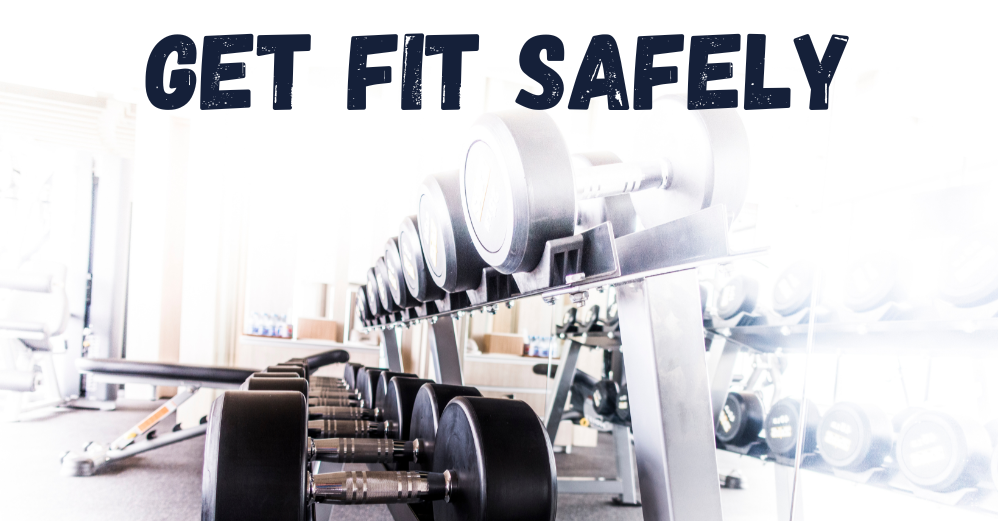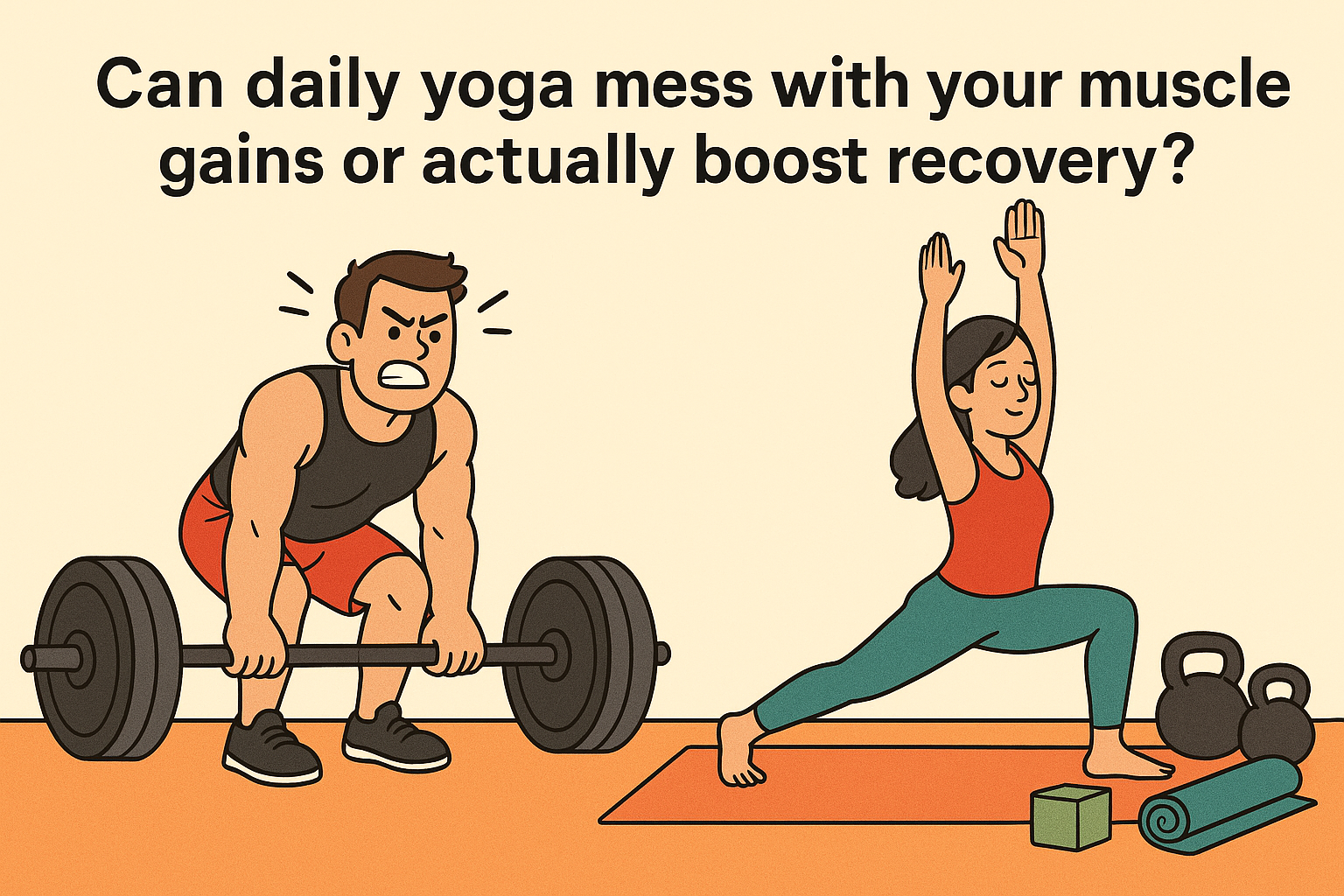Let’s put it this way. You just finished leg day.
Your legs are wrecked.
Your quads feel like they’re going to explode, your hamstrings are screaming bloody revenge, and your glutes… don’t even register anymore.
You’re walking like someone swapped your knees for two rusty pipes.
Then someone (probably wearing a suspiciously serene yoga smile) suggests:
“Why not try a little yoga? It’ll help your recovery.”
Wait, what?!
Stretching?
After squatting like you were lifting a burning car off a kitten?
I know what you’re thinking.
“You’re asking me to torture myself again—only this time with incense?”
Still, it’s a question worth exploring:
Does doing yoga after leg day actually help muscle recovery, or could it slow it down?
Let’s break it down.
How many types of yoga are there? And which ones are good after leg day?
If you’re new to the yoga world, just know—it’s not one-size-fits-all.
There’s no such thing as the yoga, like there’s only one universal class.
It’s kind of like saying “I play sports.” Cool. But what kind? Rugby or lawn bowling?
Here’s a quick cheat sheet of the most common types of yoga, so you know what to pick post-leg day (and what to avoid like the plague):
🟢 Yin Yoga
Perfect after a workout.
Slow movements, long-held poses, all on the floor.
Helps deeply relax the muscles and open up your joints.
Zero effort, max release. If you’ve got DOMS, this is your best friend.
🟢 Restorative Yoga
Even more relaxing than yin.
You lie down, get cozy, use pillows, and just breathe.
It’s like a meditation session with physical side effects.
Ideal if you’re wiped out and just want to help your body recover.
🟡 Hatha Yoga
Basic, slow, and accessible. Can be great—but depends on the instructor.
Some make it gentle, others turn it into a sneaky sweat-fest.
Ask what the class is like. If it’s chill, you’re good.
🟡 Vinyasa Yoga
Dynamic flow, smooth movements synced with breath.
Great for mobilizing, but not ideal right after a heavy leg day if you’re sore.
If you’re feeling fresh and just want to loosen up, it works.
🔴 Power Yoga / Hot Yoga
No. No. And still no.
Fast-paced, intense, physically demanding.
It’ll finish what leg day started—and not in a good way.
Skip it for at least 48 hours.
🟡 Ashtanga Yoga
Fixed series, fast pace, lots of strength and mobility focus.
Very technical and demanding.
Not meant for recovery—it’s a full workout.
Skip it if your legs are toast.
In short?
If your body needs recovery: 🎯 Yin or Restorative all the way.
If you’re feeling a bit better: 🤝 Light Hatha or soft Vinyasa—but take it easy.
If you’re tempted by hot or power yoga: 🚫 Stop. Hydrate. Reconsider.
The myth: “Stretching kills your gains”
I swear, I hear this in the gym at least once a month.
“If you stretch too much after training, you lose your gains. The muscle relaxes, deflates, and boom—bye-bye growth.”
It’s like a fitness horror story: The Cursed Stretch of the Regretful Calisthenics Bro.
But reality is way less dramatic.
That idea came from a few (kinda old) studies showing that static stretching before lifting could temporarily reduce explosive strength.
But we’re not talking about yoga before squats.
We’re talking about after. Or even the next day.
And that changes everything.
What actually happens to your muscles after a real leg day
When you squat, lunge, Romanian deadlift or leg press, you’re creating micro-tears in your muscles.
And that’s exactly how growth happens.
Your body detects the “damage” and kicks off a repair process:
- Controlled acute inflammation
- Flood of nutrients and growth factors
- Protein synthesis to rebuild stronger than before
But along with all that… comes pain.
- DOMS (Delayed Onset Muscle Soreness)
- Stiffness that makes you feel like a zombie
- The infamous “I can’t sit down without cursing the universe”
And that’s exactly where yoga comes in.
The real benefits of yoga after leg day (not just “you’ll feel better”)
Let’s make a key distinction.
Doing yoga right after your last squat set—when you’re still shaking, drenched, and your heart’s racing—is not ideal.
A tough yoga session within 30 minutes of lifting could actually mess with the acute inflammation process that kicks off recovery.
And while that might sound weird, that inflammation is crucial—it’s the first stage of muscle adaptation and growth.
But if you do yoga a few hours later, or even better, the next morning, after your body has already started repairing…
That’s when things change.
You enter what we could call the magic zone of active recovery.
That window where yoga no longer interferes—
but actually supports the process.
Here’s what really happens when you do yoga at that sweet recovery moment:
✅ Promotes active recovery without overload
Gentle yoga gets you moving without stressing already damaged muscle fibers.
Result? Faster recovery without interrupting the good inflammation.
✅ Boosts peripheral circulation
Gentle poses, fluid motion, and deep breathing help blood flow to sore muscles.
More blood = more oxygen + nutrients = faster repair.
✅ Improves lymphatic drainage
The lymph system doesn’t move itself—it needs motion and breath.
Yoga gets it going, flushing out waste, extra fluid, and local inflammation.
It’s why you feel “less puffy” after a slow session.
✅ Reduces joint stiffness
After squats, lunges, press, or pistols, your hips and knees feel like rusty hinges.
Yoga gently reopens those joints.
Flexibility returns—and with it, your freedom of movement.
✅ Helps fix imbalances and compensation patterns
We tend to overload one side, or let the quads do all the work while hamstrings nap.
Yoga helps you feel those imbalances and start correcting them.
Less compensation = fewer long-term injuries.
✅ Regulates your nervous system (and lowers cortisol)
Leg day leaves your nervous system hyped up.
Yoga activates the parasympathetic side (rest and repair mode), lowers cortisol, and gets your body into true regeneration.
Translation: better sleep, faster recovery, deeper healing.
✅ Makes DOMS more manageable
It won’t erase the pain—it’s not magic—but it makes it less paralyzing.
Those small, mindful movements loosen the tissue without harsh stretching.
You move better and feel less “concrete quad syndrome.”
✅ Improves body awareness
You don’t just feel “where it hurts”—you start noticing how you move.
Yoga forces you to pay attention to your feet, pelvis, tension areas.
All of which carry over into better future workouts.
✅ Gives you back mental control over pain and fatigue
When you’re sore, your brain can feel just as locked up.
Slow breathing, calm rhythm, and grounded movement reset your mood.
And that alone helps you recover faster.
So what kind of yoga is actually best after leg day?

Let’s be clear.
Doing yoga doesn’t mean sweating through a 90-minute power vinyasa session with handstands and Mortal Kombat-level instructors.
Not the time.
After leg day, you want gentle, slow, mindful yoga.
Like:
- Yin yoga: long-held, supported poses that melt deep tension
- Restorative yoga: blankets, cushions, long breaths (if you fall asleep, that’s fine)
- Breath-focused flow: soft movements guided by breath—zero pushing
The goal is not to “train again.”
It’s to “create space” in your body and your mind.
It’s like saying:
“Alright muscles, you worked hard. Now I’m giving you permission to let go.”
But what if I’m already destroyed from the soreness? Should I skip it?
I get it.
When leg pain is at “hold the railing to go downstairs” level, even sitting cross-legged sounds like a nightmare.
But here’s the truth:
Gentle yoga can be the key when you’re at your most sore.
Not to stretch everything hard, but just to get moving again.
Even 10 minutes on the mat:
- Deep breathing
- Supine twist with bent knees
- Happy baby (if your hamstrings don’t revolt)
- Some pelvic tilts or hip rolls on the floor
It’s incredible how sometimes the body softens up within minutes.
It’s not just the muscles—it’s your brain saying,
“Hey, we’re safe. You can relax now.”
What does the science say? Are there studies?
Oh yes.
A 2018 study published in the Journal of Strength and Conditioning Research showed that active recovery (like light yoga or low-intensity cycling) was more effective than total rest at reducing DOMS and improving post-workout mobility.
Other studies confirm that light movement increases local blood flow, delivering more oxygen and nutrients to healing tissue.
And less stiffness = faster return to peak performance.
So no, it’s not just some zen placebo.
It’s applied physiology.
My mistake (maybe you’ve made it too)
I’ll be honest.
For years I avoided yoga like someone avoids dinner invites from crypto bros.
“Yoga’s for people who stretch in Instagram reels.”
“Real lifters don’t bend.”
Meanwhile, every leg day wrecked me for three straight days.
Stiff. Sore. Miserable.
Then one night, I tried a yin yoga class—right after a PR squat session.
I thought I’d snap in half.
But instead… I felt released.
It was brutal at first, yeah.
But by the end, I felt grounded, soft, aligned.
The next day?
No miracles, but I could sit without cursing.
Since then, yoga after leg day became a ritual.
Not always—but when I do it, I thank myself every time.
When to skip it: signs your body is saying “not today”
Okay yes, yoga can be a secret weapon…
But not always.
Some days, even attempting a Downward Dog can do more harm than good.
Watch for these signs:
- Sharp, localized pain—not the usual general soreness
- Extreme joint stiffness that makes you fear injury with basic movement
- Mental exhaustion so deep that even rolling out the mat drains you
In those cases, go for a walk, take a hot shower, or use a gentle foam roller.
Yoga isn’t supposed to be a new test to pass.
It’s there to support you—not to break you again.
What happens if you do yoga consistently after every leg day
Let’s fast forward a bit.
Imagine doing 15–20 minutes of gentle yoga after every leg day for two to three months.
What really changes?
Here’s what I’ve experienced firsthand:
- You recover faster, and can train legs more often without limping for a week
- Your squat mobility improves—especially hips and ankles
- Muscle imbalances start to smooth out, reducing knee and lower back issues
- You fear “the day after” less, so you lift with less tension and more confidence
- And surprise: your neuromuscular control improves too
You know that feeling of “being able to activate the right muscles better during training”?
That often comes from a body that’s more open, more mobile, and more in tune with itself.
And yoga does exactly that.
Yoga poses specifically helpful for people who train
If you’re one of those who just wants “what works,” here’s a practical mini-menu of yoga poses that are perfect after leg day.
You just need a mat, a block (or a thick book), and maybe a throw pillow.
No incense. No chanting. Just positions that get the job done.
🧘♂️ Supta Baddha Konasana (Reclining Butterfly Pose)
What it does: Opens inner thighs and hips without effort
How to do it:
- Lie on your back, knees bent
- Bring the soles of your feet together, let knees fall open
- Use pillows or blocks under each knee if there’s too much tension
- Arms at your sides or one hand on your chest, one on your belly
Pro tip: Close your eyes, breathe through your nose, and let your thighs relax naturally
🧘♀️ Anjaneyasana (Low Lunge)
What it does: Opens hip flexors and psoas, often tight from squats and deadlifts
How to do it:
- Start kneeling
- Step one foot forward into a lunge, front knee above the ankle
- Back knee rests on the floor, top of foot down
- Keep your torso upright—don’t shove your hips too far forward
- Arms can go overhead or stay on hips
Pro tip: Pad the back knee with a folded towel if it’s uncomfortable
🧍♂️ Uttanasana (Standing Forward Fold)
What it does: Stretches the entire posterior chain—hamstrings, calves, and back
How to do it:
- Stand with feet hip-width apart
- Exhale and fold forward from the hips
- Slightly bend the knees if needed
- Let your arms hang, or grab opposite elbows to release your neck
Pro tip: You don’t need to touch the floor—just focus on relaxing, not forcing
🧘♂️ Supine Figure 4 Stretch (on your back)
What it does: Targets glutes, piriformis, and tight hips
How to do it:
- Lie on your back, knees bent
- Cross your right ankle over your left thigh (like a “4”)
- Reach behind your left thigh and gently pull it toward you
- Relax your shoulders, keep your head down
Pro tip: If your neck tightens, place a small cushion under your head. Don’t press on your knee—let gravity do the work.
🧘♀️ Viparita Karani (Legs Up the Wall)
What it does: Boosts drainage, relaxes swollen calves and feet, soothes the nervous system
How to do it:
- Sit next to a wall
- Swing your legs up so they rest vertically
- Hips close to but not jammed against the wall
- Arms open, palms up, eyes closed
Pro tip: Place a folded blanket under your hips to elevate them slightly and increase circulation
How to use them:
Pick 3 or 4 based on how you feel.
Hold each pose for at least 3–5 slow breaths—ideally 1–2 minutes.
The secret is: never force anything.
If you feel like yawning, or your heart rate slows… you’re doing it right.
You don’t need to “do yoga well.”
You just need to do it enough for your body to say: “Thanks.” 💪🧘♂️
And what if your leg training is calisthenics-based? Same deal?
Great question.
If you’re doing pistol squats, shrimp squats, isometrics, box jumps, or bodyweight deadlift progressions…
your leg day isn’t any “easier.”
In fact, you’re often working with intense eccentric overload—
the kind of tension that produces brutal DOMS.
Add full range of motion and instability into the mix…
and you’ve got the perfect storm for next-day soreness.
In these cases, yoga is even more strategic.
It helps decompress overworked joints (especially hips, knees, and ankles),
and resets your postural control.
This isn’t about “weights vs. bodyweight.”
It’s about this:
If you train your legs hard, yoga afterward still helps.
RELATED:》》》 Can Daily Yoga Mess With Your Muscle Gains or Actually Boost Recovery?
Conclusion: yes or no to yoga after leg day?
Quick answer: Yes, but do it right.
If you go slow and soft, a few hours after training or the next day:
✅ It supports recovery
✅ Reduces stiffness
✅ Reactivates without overloading
✅ Calms your nervous system
✅ Boosts long-term mobility
If you jump into a hot, intense class straight off the leg press:
❌ You might disrupt the initial inflammatory phase (which you need to grow)
❌ You might over-stress already damaged muscles
Choose the right kind of yoga at the right time—
and it becomes your best ally on the road to stronger legs and faster recovery. 💥🧘♀️





